Abstract
Coronal fractures of the anterior teeth are a common form of dental trauma. If the original tooth fragment is retained following fracture, reattachment of the fractured fragment to the remaining tooth can provide better and long lasting esthetics, improved function, a positive psychological response, and is a faster and less complicated procedure. This paper reports on coronal tooth fracture case that was successfully treated using adhesive reattachment of fractured fragment and post placement.
Keywords: Coronal fracture, dental trauma, reattachment
INTRODUCTION
Coronal fractures of the anterior teeth are a common form of dental trauma that mainly affects the maxillary incisors because of their position in the arch.[1,2] Factors that influence the management of coronal tooth fractures include the site of fracture, size of fractured fragments, periodontal status, pulpal involvement, root maturation, biological width invasion, occlusion, and time.
One of the options for managing coronal tooth fractures, especially when there is minimal or no violation of the biological width, and the fractured fragment is retained, is the reattachment of the dental fragment. Reattachment of a fragment to the fractured tooth can provide good and long lasting esthetics because the tooth's original anatomic form, color, and surface texture are maintained. Additionally, it generates a positive psychological response and is a reasonably simple procedure that provides a more predictable long-term wear than when a direct composite is used.[3] The concept of reattachment began in 1964 when Chosak and Eidelman used a cast post and conventional cement to reattach an anterior crown segment.[4] Recent developments in restorative materials, placement techniques, and adhesive protocols allow reattachment using resin based composites. Tennery was the first to use acid etch technique for the reattachment of fractured tooth fragment.[5] Subsequently, Starkey and Simonsen have reported similar cases.[6,7]
This article reports a case on coronal tooth fracture that was successfully treated using tooth fragment reattachment along with post insertion.
CASE REPORT
A 22-year-old male patient reported to the Department of Conservative Dentistry and Endodontics at Mahatma Gandhi Dental College with the chief complaint of fractured upper anterior tooth due to a road traffic accident, 3 hours before. Patient's medical history was noncontributory. Clinical and radiographic examination revealed horizontal fractures (Ellis class III) in the gingival third regions of the crowns of maxillary left lateral incisor [Figures 1 and 2]. Patient was in acute pain and coronal tooth fragment was mobile. No mobility of the remaining tooth was recorded and surrounding intraoral soft tissues were normal. The fractured fragment was removed and washed thoroughly under running water and stored in sterile normal saline to prevent dehydration and discoloration [Figure 3]. The patient expressed the desire to maintain teeth and restore them. It was planned to reattach the fractured fragment to the remaining tooth and patient's consent was obtained. Root canal treatment was carried out immediately and obturation was done by sectional method maintaining 5 mm apical seal [Figure 4]. After preparing the post space with pesso reamer, prefabricated metal post was luted in the canal with glass ionomer cement [Figure 5]. A hole was prepared on palatal side of fractured tooth fragment and then etched with 37% orthophosphoric acid, rinsed, blot dried with paper points, and bonding agent (Prime and Bond NT, Dentsply) was applied. Subsequently, flowable composite (Grandio Flow, Voco) was used to fill the access cavity and hole in the tooth and the prepared grooves into the coronal fragment [Figure 6]. The fragment was carefully seated on the remaining tooth and light cured. During curing, firm and stable finger pressure was applied to the coronal fragment to closely oppose it to the tooth. After curing, excess composite was removed with a diamond finishing bur. Afterwards, final polishing was done with Enhance (Dentsply) [Figure 7]. Follow-up examinations were carried out at 20 months interval. The tooth remained normal in esthetics and function.
Figure 1.
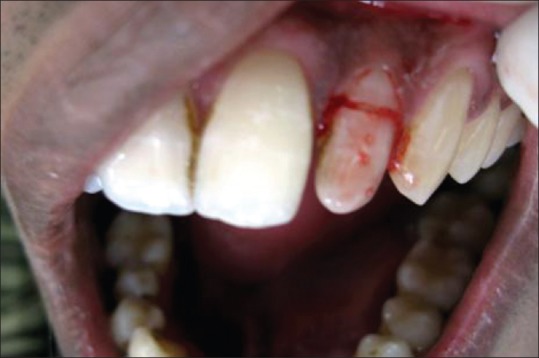
Preoperative frontal view
Figure 2.
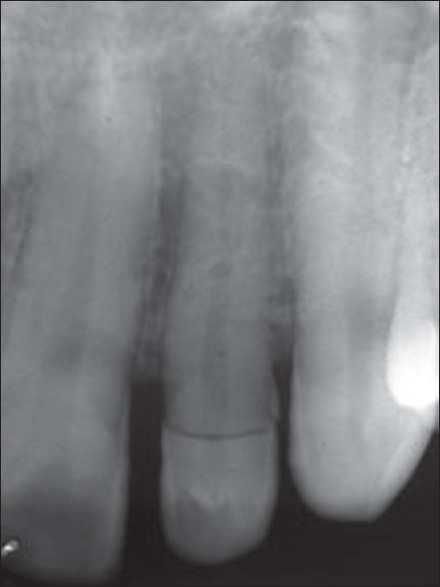
Preoperative radiograph
Figure 3.
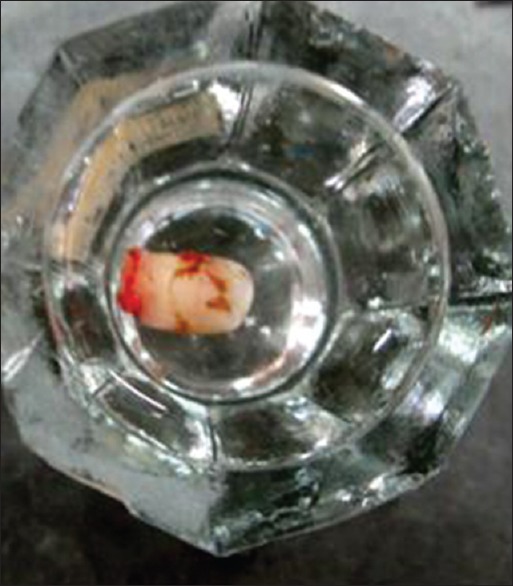
Tooth fragment kept in normal saline
Figure 4.
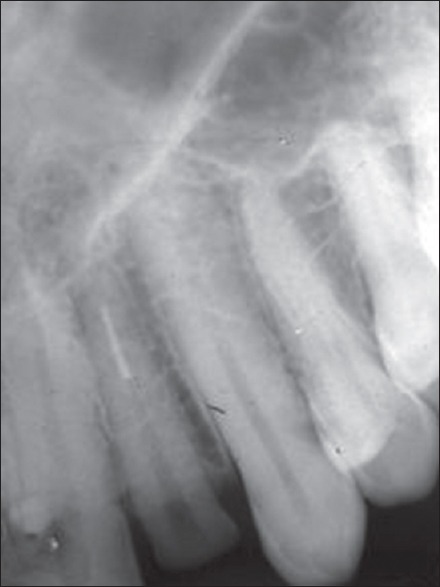
Root canal treatment with sectional method of obturation
Figure 5.
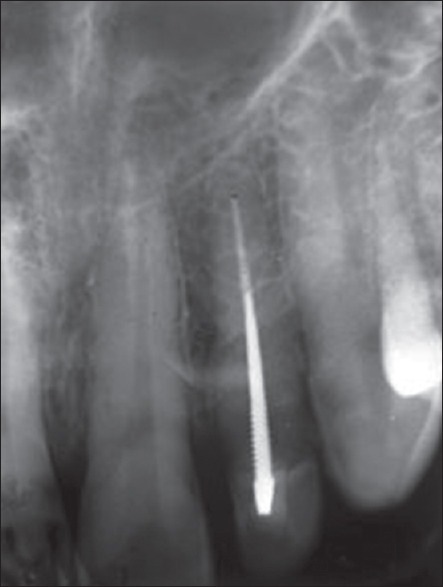
Prefabricated post inserted into canal
Figure 6.
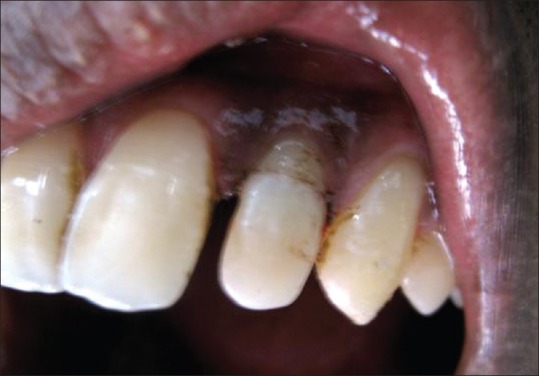
Photograph after reattachment of tooth fragment
Figure 7.
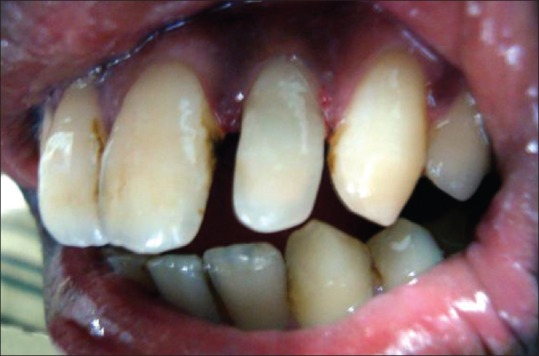
Postoperative frontal view after finishing and polishing
DISCUSSION
The remarkable advancement of adhesive systems and resin composites has made reattachment of tooth fragments a procedure that is no longer a provisional restoration, but rather a restorative treatment offering a favorable prognosis. However, this technique can be used only when the intact tooth fragment is available.[8]
In the present case, a conservative approach was adopted and the fractured fragments were reattached with the use of post for retention, like many previously reported cases.[9,10] Post provides excellent retention with long-term stability of restored portion.
CONCLUSION
Thus it can be concluded that tooth fragment reattachment along with post insertion is a viable technique that restores function and esthetics with a very conservative approach, and should be considered when treating patients with gingival third level coronal fractures of the anterior teeth.
ACKNOWLEDGMENT
I would like to thank Ajay Choudhary, Department of Conservative Dentistry and Endodontics and NIMS Dental College, Jaipur, for his knowledge, wisdom and his guidance in this study.
Footnotes
Source of Support: Nil.
Conflict of Interest: None declared.
REFERENCES
- 1.Dietschi D, Jacoby T, Dietschi JM, Schatz JP. Treatment of traumatic injuries in the front teeth: Restorative aspects in crown fractures. Pract Periodontics Aesthet Dent. 2000;12:751–8. [PubMed] [Google Scholar]
- 2.Hamilton FA, Hill FJ, Holloway PJ. An investigation of dento-alveolar trauma and its treatment in an adolescent population. Part 1: The prevalence and incidence of injuries and the extent and adequacy of treatment received. Br Dent J. 1997;182:91–5. doi: 10.1038/sj.bdj.4809313. [DOI] [PubMed] [Google Scholar]
- 3.Baratieri LN, Monteiro S, Jr, Caldeira de Andrada MA. Tooth fracture reattachment: Case reports. Quintessence Int. 1990;21:261–70. [PubMed] [Google Scholar]
- 4.Chosak A, Eidelman E. Rehabilitation of a fractured incisor using patient's natural crown: Case report. J Dent Child. 1964;31:19–21. [Google Scholar]
- 5.Tennery NT. The fractured tooth reunited using the acid-etch bonding technique. Tex Dent J. 1978;96:16–7. [PubMed] [Google Scholar]
- 6.Starkey PE. Reattachment of a fractured fragment to a tooth – A case report. J Indiana Dent Assoc. 1979;58:37–8. [PubMed] [Google Scholar]
- 7.Simonsen RJ. Restoration of a fractured central incisor using original teeth fragment. J Am Dent Assoc. 1982;105:646–8. doi: 10.14219/jada.archive.1982.0436. [DOI] [PubMed] [Google Scholar]
- 8.Simonsen RJ. Traumatic fracture restorations: An alternative use of the acid etch technique. Quintessence Int Dent Dig. 1979;10:15–22. [PubMed] [Google Scholar]
- 9.Christensen GJ. When to use fillers, build-ups or posts and cores. J Am Dent Assoc. 1996;127:1397–8. doi: 10.14219/jada.archive.1996.0459. [DOI] [PubMed] [Google Scholar]
- 10.Hayashi M, Takahashi Y, Imazato S, Ebisu S. Fracture resistance of pulpless teeth restored with post-cores and crowns. Dent Mater. 2006;22:477–85. doi: 10.1016/j.dental.2005.03.017. [DOI] [PubMed] [Google Scholar]


